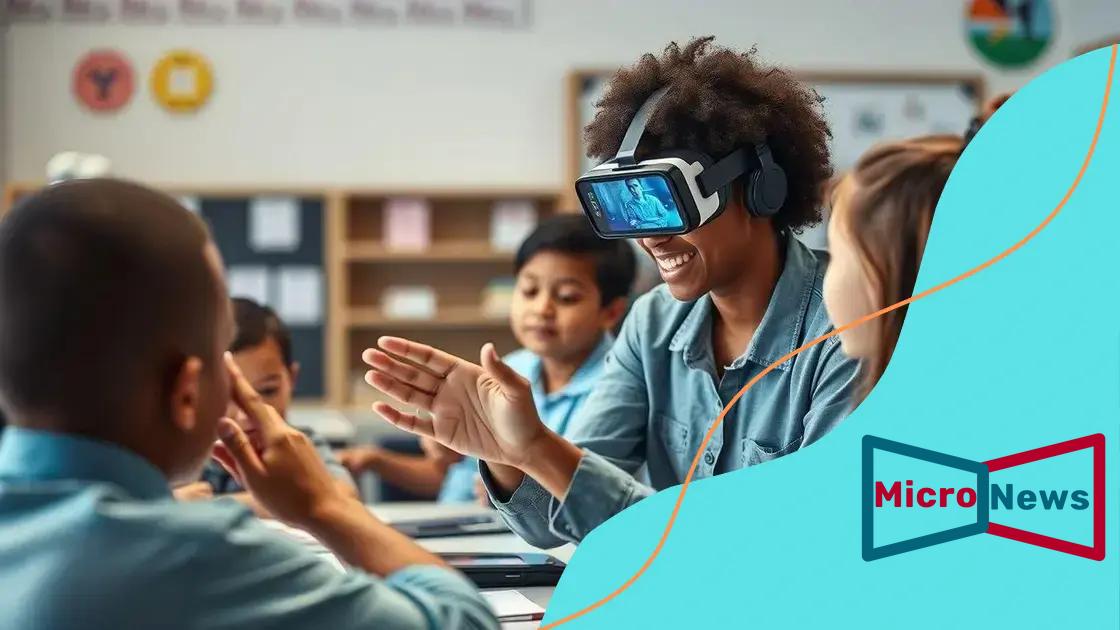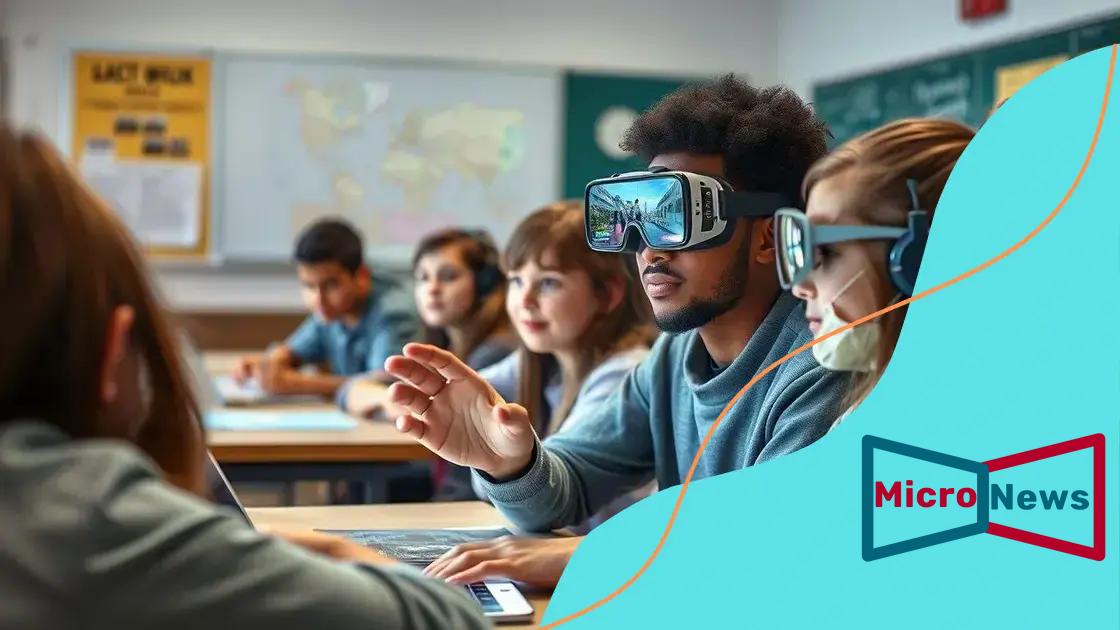How AR is being used for hands-on learning experiences

Augmented reality (AR) is transforming hands-on learning experiences by creating interactive environments that engage students, enhance retention, and foster collaboration while addressing challenges like teacher training and technical support.
Have you ever thought about how AR is being used for hands-on learning experiences? This innovative technology is reshaping the way students engage with their studies, making learning more interactive and practical. Let’s dive into how AR can enhance education.
Understanding augmented reality in education
Understanding augmented reality in education holds great promise for enhancing how students learn. This innovative technology blends virtual elements with the real world, creating exciting learning opportunities. As educators explore its benefits, AR is quickly becoming a valuable tool for both teachers and students.
What is Augmented Reality?
Augmented reality (AR) is the integration of digital information with the user’s environment in real time. Unlike virtual reality, which creates a fully immersive experience, AR overlays digital content onto the physical world. This unique feature allows learners to interact with both tangible objects and virtual elements simultaneously.
Benefits of AR in Education
Implementing AR in educational settings offers numerous advantages:
- Enhanced engagement: Students are more likely to participate actively in lessons that use AR technology.
- Better retention: Interactive experiences help students remember information more effectively.
- Accessibility: AR can make complex subjects easier to understand, catering to different learning styles.
- Collaboration: AR encourages teamwork as students work together on projects that combine the real and digital worlds.
These benefits contribute to a more dynamic and productive learning environment. As schools and institutions adopt AR, they are witnessing positive shifts in student motivation and achievement.
Schools that embrace augmented reality often incorporate it into science, history, and art lessons. For example, imagine a biology class where students can explore 3D models of cells or anatomy in real time. This direct interaction with content boosts their comprehension and sparks curiosity.
Moreover, AR applications can provide opportunities for hands-on experiences, such as virtual field trips that allow students to explore historical landmarks or scientific phenomena without leaving the classroom. This method not only enriches learning but also broadens students’ perspectives.
Benefits of AR for hands-on learning
There are many benefits of AR for hands-on learning that enhance educational experiences. This technology allows learners to engage deeply with the material, making lessons more interactive and memorable. By adding a layer of digital information to the physical world, students can explore concepts in ways that were not possible before.
Increased Engagement
One of the key benefits of AR is the boost in student engagement. When learners interact with augmented reality, they become active participants in their education. This excitement can lead to improved focus and interest in the subject matter.
Improved Retention
Research shows that students retain more information when they can visualize data. AR helps create a multi-sensory learning environment, where students can see, hear, and even manipulate objects. This direct interaction leads to enhanced memory retention.
- Visual Learning: Graphical representations aid understanding.
- Interactive Experiences: Students can physically interact with concepts.
- Immediate Feedback: AR provides real-time results in simulations.
Moreover, AR caters to various learning styles. Visual learners benefit from graphics, while kinesthetic learners thrive on hands-on activities. By meeting different preferences, AR accommodates a broader range of students.
Furthermore, AR can create real-world scenarios for practice. For instance, students can conduct virtual science experiments or explore historical events. Such experiences build skills applicable to real-life situations, making learning relevant and exciting.
Additionally, AR promotes collaboration among students. When working on AR projects, learners often team up, sharing ideas and solving problems together. This collaboration fosters social skills and teamwork, essential in today’s working environment.
Real-world applications of AR in classrooms

Understanding the real-world applications of AR in classrooms reveals its immense potential to transform education. Augmented reality can bridge the gap between theory and practice, making lessons more relatable and exciting for students. This innovative tool helps bring subjects to life.
Interactive Lessons
Teachers can use AR to create interactive lessons that engage students in different subjects. For instance, in a history class, students can explore ancient civilizations through AR simulations, walking through virtual recreations of historical sites.
STEM Education
In STEM education, AR applications allow students to visualize complex concepts. Science classes can integrate AR to showcase atom structures or body systems. Students can see how systems interact, understanding processes in real time.
- Science experiments: Perform virtual experiments without the risk of physical hazards.
- Mathematical concepts: Use AR tools to understand geometric shapes and their properties.
- Engineering projects: Simulate engineering designs and test them in a virtual environment.
AR not only enhances learning in subject areas but also boosts creativity. Students can design their own virtual models, experimenting with ideas without limitations. This hands-on approach encourages critical thinking and problem-solving.
Moreover, language learning benefits greatly from AR. Students can interact with words and phrases in context, making it easier to remember vocabulary and grammar rules. For example, pointing a device at an object could display its name in a different language, developing practical language skills.
Additionally, AR can strengthen collaboration among students. Group projects using AR tools allow learners to share ideas and work together to create unique presentations or virtual scenarios. This interaction enhances teamwork skills and builds a sense of community in the classroom.
Challenges of integrating AR into learning
Integrating AR into learning brings exciting possibilities, but it also comes with challenges that educators must address. Understanding these hurdles can help teachers effectively implement AR tools in their classrooms. One major challenge is the need for proper training.
Teacher Training
Teachers may lack experience with augmented reality technology. Training is essential to help them understand how to use AR effectively in lessons. Without adequate support, teachers might struggle to integrate AR into their teaching practices.
Technical Issues
Technical problems can hinder the use of AR in education. Devices may not work properly, or software might be difficult to navigate. Inconsistent access to technology can limit students’ ability to participate in AR activities.
- Device compatibility: Different devices may not support the same AR applications.
- Internet connectivity: AR often requires a stable internet connection to function well.
- Software updates: Keeping AR applications updated can be challenging.
Another issue is ensuring that content is age-appropriate and relevant. Not all AR resources are suitable for every age group. Educators need to evaluate materials critically to ensure they align with learning objectives.
Additionally, cost can be a significant barrier. Not all schools have the budget to purchase AR tools or the necessary devices. This financial constraint may limit the availability of AR experiences for some students, creating disparities in learning opportunities.
Moreover, student distractions can be a concern. While AR engages learners, it can also divert attention from the core lesson. Students might focus more on technology than on the content itself. Finding ways to keep students on task during AR activities is essential for effective learning.
Future trends of AR in educational methods
The future trends of AR in educational methods look promising as technology continues to advance. Educators and developers are finding new ways to incorporate augmented reality into lessons, enhancing how students learn. One significant trend is the rise of personalized learning experiences.
Personalized Learning
As AR technology improves, the ability to tailor educational content to individual student needs will become more prevalent. This means students can learn at their own pace, focusing on areas where they need more support. AR can adapt information based on a student’s learning style, making education more effective.
Gamification
Gamification is another trend that will shape the future of AR in education. By turning lessons into games, students are more likely to engage with the material. AR can provide interactive challenges, rewards, and immersive experiences. This approach keeps learning fun while reinforcing important concepts.
- Interactive quizzes: Use AR to create quizzes where students interact with virtual objects.
- Virtual competitions: Encourage friendly competition among students through AR-based games.
- Scenario-based learning: Allow students to solve real-world problems using AR simulations.
Moreover, collaborative AR experiences will gain popularity. Students can work together in real-time with their peers, regardless of their physical location. This connection can enhance teamwork skills while making learning more inclusive.
AR will also increasingly integrate with other technologies, such as artificial intelligence. This integration can provide real-time feedback and suggestions based on a student’s performance. For example, AI could analyze how a student interacts with AR content and provide tips for improvement.
Furthermore, as AR tools become more affordable, more schools will adopt this technology. Increased access will lead to a broader standardization of AR in the curriculum, allowing students from diverse backgrounds to benefit from enhanced learning experiences.
FAQ – Frequently Asked Questions about Augmented Reality in Education
What is augmented reality (AR) in education?
AR in education is a technology that overlays digital information onto the real world, providing interactive learning experiences.
How can AR enhance student engagement?
AR makes lessons more interactive and fun, capturing students’ attention and encouraging them to participate actively in their learning.
What are some benefits of using AR in classrooms?
Benefits include personalized learning, improved retention of information, and enhanced collaboration among students.
What challenges do schools face when integrating AR?
Challenges include the need for teacher training, technical support, and ensuring access to appropriate devices and resources.





